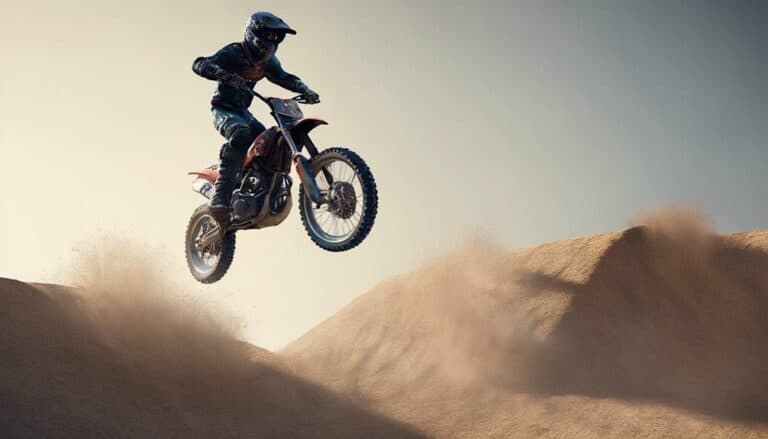When tackling different types of dirt bike jumps, think of your approach like adjusting your grip on the throttle for changing terrain—it's essential to adapt.
Each jump, whether it's a kicker, tabletop, double, or triple jump, demands a unique strategy for a successful ride.
But how exactly do you tailor your technique to conquer these various jumps effectively?
Stay tuned to discover the nuanced differences in approach for each type of jump, and how mastering these techniques can elevate your dirt biking game to new heights.
Key Takeaways
- Consistent speed and throttle control are crucial for single jumps.
- Double jumps require precise throttle control and alignment for smooth clearance.
- Tabletop jumps necessitate balanced speed and precise front wheel lift.
- Step-up/step-down jumps demand speed adjustment and proper body positioning for elevation changes.
Types of Dirt Bike Jumps
When approaching different types of dirt bike jumps, riders must understand the specific characteristics and challenges posed by each jump style.
Tabletop jumps offer a flat, even surface for both takeoff and landing, allowing for smooth shifts without the need to clear a gap.
Double jumps feature two separate launching and landing zones, demanding precise speed and control to navigate successfully without risking a nose dive.
Step-up jumps present a unique challenge with an inclined landing, requiring riders to maintain momentum and control to conquer the upward slope effectively.
Triple jumps take it a step further with three consecutive launch and landing areas, testing riders' skills and timing to perfection.
Each type of jump demands a different approach to guarantee a safe and successful ride. Understanding how to position your front tire and adjust your body weight can make all the difference between a smooth landing and a potential disaster.
Approach for Single Jumps
Approach single jumps by maintaining consistent speed and throttle control to guarantee ideal momentum and lift-off. Adjust your body positioning by leaning slightly back, preloading the suspension to generate the necessary lift as you hit the jump.
It's crucial to focus on hitting the takeoff ramp squarely, making a smooth and stable flight through the air. Use visual markers on the jump face to help gauge timing and prepare for the correct launch angle.
As you approach the landing, maintain a relaxed grip on the handlebars and engage in proper body positioning to maintain control and stability upon touchdown. By following these techniques and maintaining focus throughout the entire process of the jump, you can optimize your performance and ensure a successful takeoff and landing.
Approach for Double Jumps
To successfully navigate double jumps, maintain a steady speed and precise throttle control to smoothly clear both takeoff and landing zones. As you approach the first jump, make sure you have enough power to carry you through the gap and onto the second jump.
It's important to maintain a neutral riding position to handle the distance between the jumps effectively. Adjust your body positioning to align the bike's trajectory with the landing of the second jump, allowing you to smoothly shift between the two.
Use your legs to absorb the impact from the first jump, preparing yourself for the launch onto the second jump. Focus on staying balanced and in control throughout the sequence, keeping your eyes forward to see the landing and make any necessary adjustments.
Approach for Tabletop Jumps
Traversing tabletop jumps successfully requires sustaining a consistent speed and balanced approach to smoothly clear the flat surface ahead. As you approach the jump, make sure you maintain a neutral attack riding position. This position helps evenly distribute your weight, giving you better control over the bike's trajectory. Adjust your speed according to the length of the tabletop. This adjustment is essential to make sure you reach the landing zone comfortably without overshooting or coming up short.
To execute the jump effectively, focus on lifting the front wheel slightly as you approach the tabletop. This action helps prevent casing, where the bike's frame hits the edge of the tabletop, disrupting your momentum. Additionally, practice precise throttle control and body positioning. By leaning forward and engaging the throttle at the right moment, you can achieve a level flight over the tabletop, smoothly clearing it with confidence and finesse. Mastering these techniques will enhance your performance when tackling tabletop jumps.
Approach for Step-up/Step-down Jumps
When hitting step-up/step-down jumps, adjust your speed and body positioning to account for the changing elevation and terrain. For step-up jumps, approach with increased speed to clear the upward slope of the landing. Maintain a neutral attack riding position while accelerating, ensuring throttle control to provide the necessary momentum and lift. Anticipate the need for more power compared to other jump types.
As you hit the jump, shift your body weight slightly forward to help the front wheel rise with the terrain. This adjustment aids in keeping the bike balanced and level in the air. Additionally, be prepared to far forward upon landing, ensuring a smooth and controlled touchdown on the elevated surface.
Conclusion
So there you have it, folks. Remember, mastering the art of dirt bike jumps is no easy feat. It requires precision, skill, and a touch of fearlessness.
But hey, if you're not willing to push the limits, then why even bother strapping on that helmet? Keep practicing, keep honing your techniques, and soon enough, you'll be soaring through the air like a true daredevil.
Just don't forget to hold on tight and enjoy the ride!

